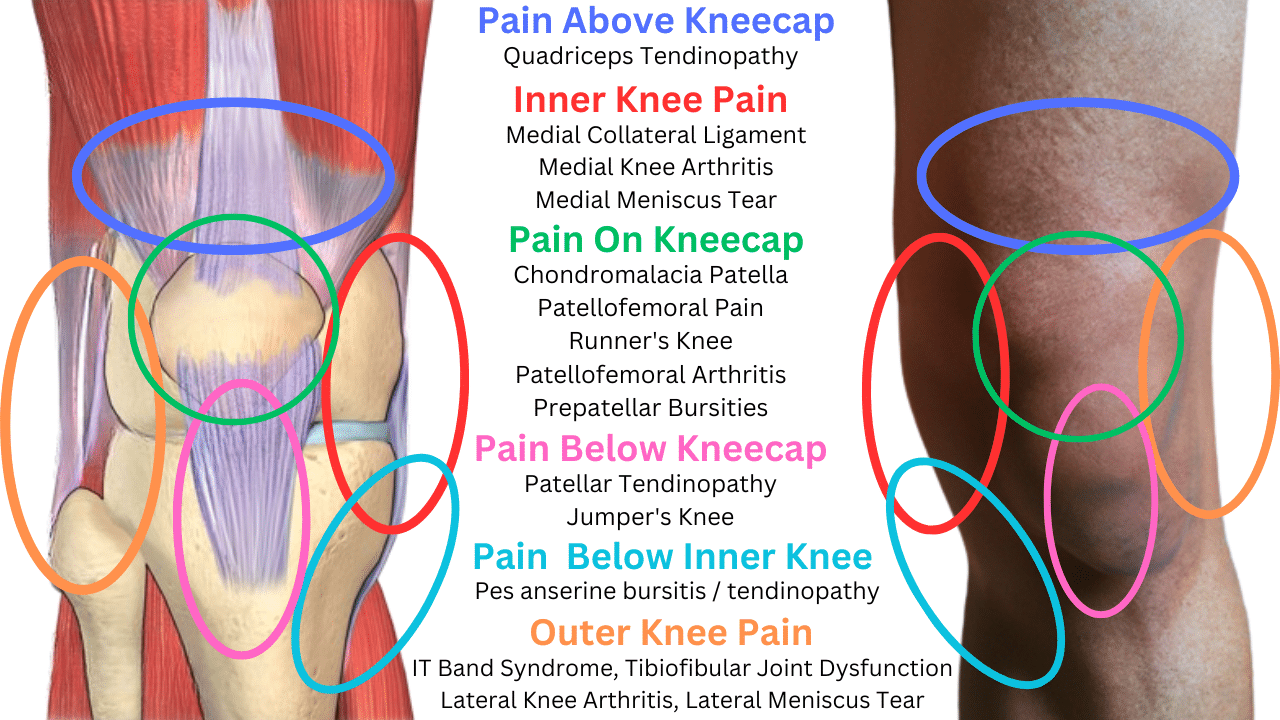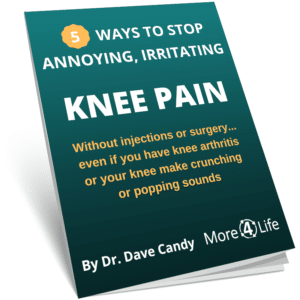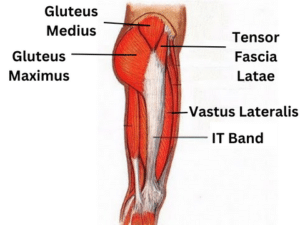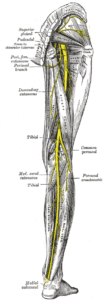If you have knee pain, it can be worrisome, especially if you don't understand what's causing it, if it's something serious, or how long it will take to go way.
Use the Knee Pain Location Chart below to find what structures may be causing your pain.
Then learn more about each of the causes below, plus treatment options to help each one.

Pain Located Above The Kneecap
Quadricep Tendinopathy
Your kneecap is contained inside of your quadriceps tendon. The quadriceps is the main muscle group on the front of your thigh that straightens your knee.
However, when you're using excessive force from your quadriceps such as distance running or landing from a jump, that can put extra stress on the quadriceps tendon, as well as the patellar tendon below the knee.
This is particularly true if you've recently increased your training volume and your muscles haven't gotten used to the new workload yet.
Stretching your quadriceps is one good treatment for quadriceps tendonitis.
Additionally, doing exercises like squats and lunges can help strengthen both your quads and your gluteal (buttock) muscles.
Pain Located On The Inside Of The Knee
Inner knee pain is very common, especially in people who walk o run a lot.
Medial Collateral Ligament (MCL) Sprain
If the pain is directly over the inner knee joint line, it could be due to a sprain of your medial collateral ligament.
However, that ligament is very strong and it usually doesn't get sprained unless you have a traumatic injury. Examples of such injuries include twisting your knee when playing sports or having a contact sports injury.
Medial Knee Arthritis
If you've just started having knee pain for no reason, there's a chance you could have some medial knee arthritis.
Knee arthritis is when the you start to lose cartilage in your knee. Knee arthritis can occur on the inner side of the knee, the outer side of the knee, or behind the kneecap.
The cartilage that associated with knee arthritis is called articular cartilage. However, there's another type of cartilage between the two bones (tibia and femur) of your knee joint.
That type of cartilage is called fibrocartilage.
Medial Meniscus Tear
The fibrocartilage between your tibia and femur is called the meniscus. There's a medial meniscus located on the inner side of your knee joint as well as a lateral meniscus located on the outer side of your knee joint.
The medial meniscus is the more commonly injured of the two menisci. It can be injured acutely with a sports injury such as pivoting on cutting to quickly on a planted foot.
Medial meniscus tears can also occur over time due to hip weakness or overpronation when walking. This type of meniscus tear is referred to as degenerative.
Medial meniscus tears can cause pain located deep inside the knee or along the inner knee joint.
Depending on the size and location of the tear, sometime surgery is required. However, often meniscus tears respond well to exercise and other conservative treatment options.
Pain Located At The Kneecap
Patellofemoral Arthritis
As stated above, one cause of pain behind the kneecap is patellofemoral knee arthritis. (patella = kneecap, femur = thigh bone)
However, there are other causes of pain located behind the kneecap as well.
Chondromalacia Patella
Chondromalacia patella is a mild precursor to arthritis that can start as young as the teenage years. It can cause knee pain located behind the patella during activity such as going up and down stairs. Chondromalacia patella can also cause knee pain when sitting for long periods of time.
Patellofemoral Pain Syndrome
Another cause of kneecap pain is something called Patellofemoral Pain Syndrome, otherwise known as Runner's knee.
Largely, whenever a diagnosis has the word syndrome attached to it, it's medical speak for "a cluster of signs and symptoms that we don't fully understand".
Most of the time, that's because patellofemoral pain is heterogeneous - meaning there are different varieties of it.
Patellofemoral pain can be due to stiff quadriceps or an IT band problem. It can also be due to a patellar instability, meaning your kneecap is prone to popping out of place.
Finally, pain on the front of the kneecap can be caused by prepatellar bursitis.
This is when the fluid sac on the front of your knee ruptures. This usually comes from prolonged kneeling on your knee or from a fall or other blunt force to the knee.
Pain Located Below The Kneecap
Patellar Tendinitis / Tendinopathy
Pain below the kneecap is most commonly caused by patellar tendonitis / tendinopathy.
In truth, most "tendonitis" problems (-itis = inflammation) are non-inflammatory. Therefore, they should more properly be called "tendinopathies". However, there are cases where an acute patellar tendon injury can be inflamed.
Much like quadriceps tendinopathy mentioned above, patellar tendonitis is often due to stiff, overactive quadriceps and underactive gluteal muscles.
Overtraining, especially with high-impact activities such as jumping, are often at fault. That's why patellar tendonitis is sometimes referred to as Jumper's knee.
Learn more about pain on the front of the knee.

Pain Located Below The Inner Knee
Earlier in this post, I mentioned pain located on the inner knee joint line.
However, one of the most common causes of pain on the inside of the knee is actually below the knee itself.
Pes Anserine Tendonitis / Bursitis
There are three tendons that attach on the inner side of the leg just below the knee that are collectively referred to as the "Pes Anserine" tendons.
Those tendons are the sartorius, gracilis, and semitendinosus (hamstring).
There's a bursa at their attachment site, so you can develop either pes anserine bursitis, or you can develop a tendinitis or tendinopathy of the tendons themselves.
This often happens due to excessive twisting at the knee from weak hip rotator muscles or overpronation of the foot from flat feet or stiff calves.
Learn 2 easy tips to help pain on the inside of the knee from pes anserine problems.
Pain Located On The Outer Knee
IT Band Syndrome
Pain located on the outside of the knee can is most commonly caused by IT band syndrome.
Iliotibial band syndrome (a.k.a. IT band syndrome) is most common in runners.
Lateral Meniscus Tear
If the pain feels deep inside the outer part of the knee, it could also be from knee arthritis or a lateral meniscus tear. Although less common than medial meniscus tears, lateral meniscus tears can be just as painful. Symptoms may include pain with weightbearing, twisting, or even getting a sensation of locking in the knee. You may notice pain when bending the knee as well as pain when straightening the knee.
Proximal Tibiofibular Joint Dysfunction
As you can see on the Knee Pain Location Chart above, there's a joint between the two lower leg bones, the tibia and the fibula. A dysfunction with this joint, the proximal tibiofibular joint, can cause pain located on the outside of the knee.
Common Fibular Nerve Irritation
Additionally there's a nerve called the common fibular (peroneal) nerve that runs behind this joint.
Irritation of this nerve can cause numbness and tingling in the lower leg and foot.
Learn more about pain on the outside of the knee.
Pain Located In Back Of The Knee
Although not shown on the Knee Pain Location Chart above, pain in the back of the knee can be caused by a variety of different problems including meniscus tears, a Baker's cyst, stiff calves or hamstrings, or your sciatic nerve.
Learn about causes of pain in the back of the knee.
Conclusion
Hopefully you found our Knee Pain Location Chart to be helpful in figuring out what's causing your knee pain.
It's important to note that while the chart covers many of the most common causes of knee pain, it does not cover ALL causes of knee pain, nor should it be used as a substitute for getting your knee pain assessed by a professional.
If you live in the St. Louis area and need help for knee pain, tap the button below to request an appointment with one of our specialist physical therapists.




